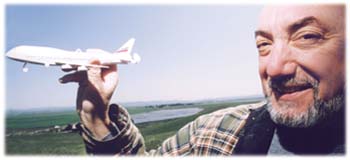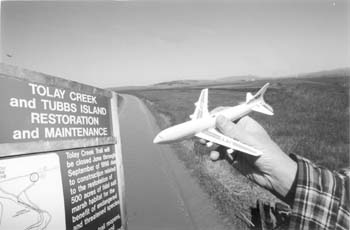![[MetroActive Features]](/gifs/feat468.gif)
[ Features Index | Sonoma County Independent | MetroActive Central | Archives ]
Terminal Voracity
Point of departure: Harvey Goldberg wants to transform local wetlands into an international jetport. Critics say he's on a collision course with environmental disaster.
If Harvey Goldberg gets his way, Sonoma County soon will be sprouting jumbo jets full of well-heeled tourists
By Janet Wells
THE SIGN IS SCRAWLED in black ink on plain white fax paper. It reads: "North Bay International Airport: Welcome to the Wine Country." But Petaluma farmer Harvey Goldberg is convinced that it should be larger than life, the gateway marquee to the Bay Area's fourth major jet airport, located smack in the middle of the marshy San Pablo baylands north of Highway 37.
Goldberg's idea isn't out of left field, exactly. One of a group of North Bay farmers wrestling with increased government regulation of some of San Francisco Bay Area's last large tracts of open land, Goldberg is looking to protect the economic potential of farmlands in southern Sonoma and northern Marin counties.
Goldberg and other members of the North Bay Agricultural Alliance are chafing against recommendations made recently by the Bay Conservation and Development Commission to protect as much wetland habitat as possible, in part by locking farmers into growing low-impact crops such as oat hay.
"Many members have been growing hay because they have been doing it for generations," says alliance vice president Tito Sasaki. "There have been increasing regulations imposed upon their operations, which is making their practice more expensive and cumbersome, while profitability is going down."
Goldberg, clearly the alliance's renegade, is less diplomatic.
"The government regulatory agencies want to steal our land," he says. "They've come to us and spit in our face, they've lied to us, trying to devalue and steal our private property.
"There is a hidden agenda," he adds. "Once they get all this land, they will build on it. Do you think they want some stupid fat ugly farmer, someone who mowed hay all his life to get any money? No."
Goldberg doesn't discriminate when pointing the figure: "Everybody wants jurisdiction," he says. "the EPA, the BCDC, Sonoma County, Parks and Recreation, the state Water Quality Control Board, the Association of Bay Area Governments, the Coastal Conservancy, the Corps of Engineers.
"Why not let [farmers] enjoy the fruit of their labor in making the North Bay what it is?" he adds. "We came up with these ideas because we're being pushed into it by the government. We're not going to bend over."
Goldberg's vision for a better North Bay includes a state-of-the-art multibillion-dollar international airport, with high-speed ferry service through the bay and delta. While he doesn't quite have a handle on the details, Goldberg is more than willing to paint the big picture.
"From the international airport, you'll go through the international terminal and go to the monorail to transport you directly to the ferry station.," he says, his voice revving up in speed and excitement. "You could have a port authority there. We have a railroad. We have water. There are 15 counties we can get to by ferry or boat.
"We could do a world-class, next-generation, wonderful airport in the North Bay that would not change the quality of life for the people in Sonoma and the surrounding community," he adds. "With an approach coming in over the bay and going out over the bay, there wouldn't be anyone bothered."
THE INFRASTRUCTURE he envisions to handle airport traffic--widening Highway 37 to 10 lanes--might, however, rattle a few cages. "I don't mean build it all at once. Leave enough room for growth, so we don't end up with another Highway 101," he says, referring to the nearly constant congestion on the freeway.
The Federal Aviation Administration is considering putting Goldberg's proposal out for public comment, one of the first steps in a gargantuan approval process for a new international airport. "It's potentially a massive undertaking. I want to emphasize potentially," says FAA spokesman William Shumann.
Shumann cites a litany of considerations in building a new airport, including environmental and public approvals, appointment of an airport authority or government agency to oversee construction and management, air traffic systems and air space, and the difficulty in getting airlines to use the facility, since there is nothing that requires airlines to use a particular airport.
And, Shumann adds, there's the part about raising billions of dollars.
"There are two proposals to expand the runways at San Francisco airport," he says. "Each of those is over a billion dollars in estimated costs, and that's just building runways."
Then there's the issue of whether or not the Bay Area actually needs another major airport in addition to San Francisco, Oakland, and San Jose.
San Francisco International Airport is the fifth busiest in the United States, with 18.9 million passengers traveling through annually, and competing with successful passenger and cargo jet operations in Oakland and San Jose. Even with more than 1,200 landings and takeoffs daily, San Francisco wouldn't welcome another international airport in its backyard.
"Spreading three international facilities in such a small area is not a reasonable approach to international air travel," says San Francisco airport spokesman Ron Wilson. "If you put them on a map you can cover them with a quarter. I could see a reliever airport for domestic services in Marin County, but you don't need more than one major international airport in an area."
The North Bay, says Wilson, would have to buck a name-recognition issue: "You mention San Francisco and worldwide it's a place to travel to for business and tourism," he says. "Much as they want to publicize their airports, people don't recognize Oakland and San Jose as someplace they want to travel to. [The North Bay] would face that same problem."
GOLDBERG ISN'T daunted by all the potential stumbling blocks. "I heard a story about people in San Francisco talking about building the Golden Gate Bridge 70 years ago," he recounts, "and people said, 'Are you crazy? Who wants to go up there anyway?' Now everyone wants to come to Marin and Sonoma."
Still, his zeal hasn't exactly resulted in an avalanche of official enthusiasm for his airport proposal. "I don't think much of it," says Sonoma County Supervisor Mike Kerns, whose Petaluma constituents may have strong views about the proposal. "I don't think it really fits into the area, not to mention that the infrastructure just isn't there for such an endeavor."
Kerns thinks the proposed bayside area is best suited for restoration of wetlands habitat. The state BCDC, which works with local governments to protect farms and wetlands, agrees in its report "Agriculture in the North Bay."
"The local governments have [the San Pablo baylands] zoned for ag and wetlands protection. Our work is to provide them with technical information to assist them in achieving that," says Will Travis, executive director of the BCDC.
The North Bay Agricultural Alliance received a $50,000 grant from the Environmental Protection Agency to study alternative uses of their farmland, ranging from more lucrative crops to Goldberg's airport scenario. But the BCDC's report, members say, has "undermined" their study.
"We were going to examine other land uses for this area and how that will affect us and our community and the environment," Sasaki says. "If the BCDC recommends and asks other government bodies to adopt recommendations to lock us into the current mode of operation, then it becomes a moot issue to talk about different types of agriculture or some other uses."
Alliance members will meet this week to discuss whether or not to reject the EPA grant, since their study would then be regulated by a government agency that also funded the BCDC's study of the area.
While the BCDC does not have regulatory control over the San Pablo baylands, alliance members are wary of the group's power and motives,
"They might not shoot us," Sasaki says of the BCDC, paraphrasing another member of the farmers' group, "but they are certainly making the bullets."
[ Sonoma County | MetroActive Central | Archives ]
Copyright © Metro Publishing Inc. Maintained by Boulevards New Media.
![]()

Michael Amsler

MICHAEL AMSLER
From the May 13-19, 1999 issue of the Sonoma County Independent.